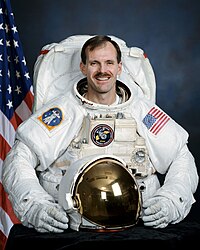Steven Lee Smith
| Steven Smith | |
|---|---|

|
|
| Country: | United States |
| Organization: | NASA |
| selected on | March 31, 1992 ( 14th NASA Group ) |
| Calls: | 4 space flights |
| Start of the first space flight: |
September 30, 1994 |
| Landing of the last space flight: |
April 19, 2002 |
| Time in space: | 40d 0h 16min |
| EVA inserts: | 7th |
| EVA total duration: | 49h 48min |
| retired on | January 2005 |
| Space flights | |
Steven Lee Smith (born December 30, 1958 in Phoenix , Arizona , USA ) is a former American astronaut .
Smith received in 1981 a Bachelor in Electrical Engineering , in 1982 a Master in Electrical Engineering and in 1987 a master's in business administration . All three degrees are from Stanford University . From 1982 to 1985 Smith worked for IBM in the Large Scale Integration Technology Group in San José (California) . Until 1989 he was product manager for the Hardware and Systems Management Group at IBM.
Astronaut activity
In 1989, Smith came to NASA, where he worked in the Mission Operations Directorate on payload preparation and assisted the teams in the control center. In 1992 he was selected as an astronaut candidate. In September 1993, Smith was assigned to a space flight as the first of his astronaut selection group. He worked for the astronauts office on the main engines, the solid fuel rocket, the outer tank and on the safety for the space shuttles . Smith was also assigned to the support teams for shuttle launches and landings at the Kennedy Space Center for a year and a half .
After his active work as an astronaut, he worked as a management astronaut until mid-2015, responsible for cooperation with ESA on the International Space Station (ISS) and, among other things, for the flights of the Automated Transfer Vehicle (ATV). Since then he has worked as deputy director for the ISS in Ames Research Center in Moffett Field ( California ).
STS-68
On his first mission, STS-68 , he flew into space on the space shuttle Endeavor on September 30, 1994. It was the Space Radar Laboratory's second flight. The two main instruments on board were the SIR-C / X-SAR (Shuttle Imaging Radar-C / X-Band Synthetic Aperture Radar) and MAPS (Measurement of Air Pollution from Satellites). On October 11th, the space shuttle landed at Edwards Air Force Base in California .
STS-82
Smith flew on the space shuttle Discovery on February 11, 1997 on the second maintenance mission for the Hubble Space Telescope (HST). Smith took part in three of the five space exits (EVA) required to repair the telescope. In addition to a tape recorder, which was replaced by a core memory, the HST received the NICMOS infrared camera and the STIS spectroscope . Two spectrographs have been expanded for this purpose.
STS-103
On December 20, 1999, Smith embarked on the next maintenance mission for the Hubble Space Telescope on the space shuttle Discovery. New instruments and system extensions were installed during this mission. As the payload commander, Smith was involved in two of the three outboard activities this time.
STS-110
On his last mission, Smith flew to the International Space Station (ISS) on April 8, 2002 on the space shuttle Atlantis . The lattice structure element S0 and a rail car were brought to the ISS. The sledge known as the “Mobile Transporter” uses the rail system laid on the grid elements. Again Smith made two space exits, making a total of seven exits into space.
Private
Steven Smith is married and claims to have two children. His hobbies are flying, diving, basketball, camping and traveling.
See also
- List of spacemen
- List of space shuttle missions
- List of manned space flights
- List of manned missions to the International Space Station
- Records of manned spaceflight
Web links
- Short biography of Steven Lee Smith at spacefacts.de
- NASA biography of Steven Lee Smith (PDF)
- Biography of Steven Lee Smith in the Encyclopedia Astronautica (English)
Individual evidence
- ^ NASA biography of Steven L. Smith , April 2017, accessed January 30, 2016 (PDF).
- ^ Preflight Interview: Steven Smith. NASA, 2002, accessed June 18, 2019 .
| personal data | |
|---|---|
| SURNAME | Smith, Steven Lee |
| BRIEF DESCRIPTION | American astronaut |
| DATE OF BIRTH | December 30, 1958 |
| PLACE OF BIRTH | Phoenix , Arizona , Arizona |